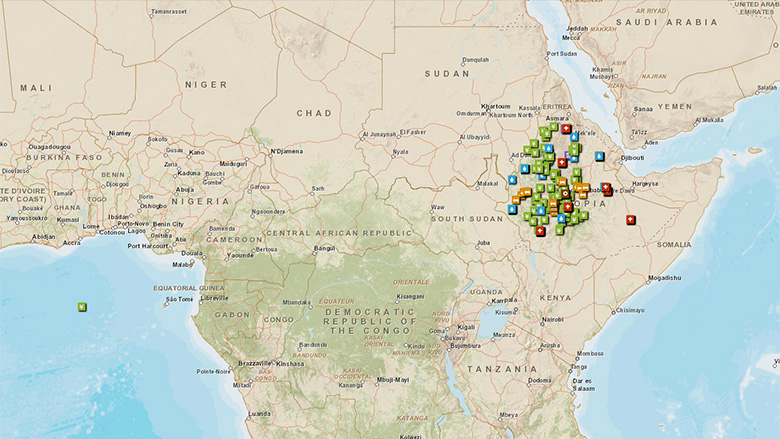Challenge
The project aimed at addressing problems and challenges presented by deficiencies in human and institutional capacity (outdated legal and policy frameworks, cumbersome work processes and systems, unwieldy structures, and shortage of important skills in the public sector), as well as issues of inclusiveness, transparency and accountability, which constituted the weakest links in past development efforts and economic performance. The project was implemented nationwide at all four tiers of government, including the federal, 11 regional states, 700 districts and 17,000 village-level administrations.
Solution
The unique features and instruments under the project are:
- Addressing the challenges in an integrated and holistic manner. The project is being implemented at all tiers of government, covers all three branches of government, and invests in skills, systems and organizational structures in core public sector areas, such as revenue sector, administrative and human resources (HR) reforms, public finance, justice and modernization through information and communications technology (ICT).
- Promoting learning-by-doing approach. The project introduced minimum mandatory requirements so that implementers sequence the basic capacity building needs first, creating a twinning arrangement between advanced and developing regional states. The project invested in monitoring and evaluation (M&E) by streamlining supply- and demand-side surveys and following top-down prototyping and local planning and implementation to ensure work is divided according to capacity.
- Integrating principles of a sectorwide approach (SWAp) and the Paris Declaration in the design. The project supports government-led homegrown reforms, uses the country’s planning, execution and reporting mechanisms, and encourages donors to support single design and use single reporting.
Results
The project has led to considerable improvement in government capabilities to:
- Raise and manage public resources: Tax collection has doubled in real terms. The tax rate for the individual income tax is progressive and the agriculture sector, consisting of 83% of the population, is lightly taxed. Fifty percent of Public Expenditure and Financial Accountability (PEFA) indicators have shown improvement between 2007 and 2010.
- Deliver improved public services: Decentralization of service delivery to districts has been scaled up from four regions to all 11 regions and as a result, 88% of local jurisdictions are providing at minimum five basic services in 2011, compared to only 25% in 2005 (Woreda/District and City Benchmarking Survey, 2011). The business process review (BPR) has clarified strategies, simplified work processes and established service standards in over 20,000 offices across the nation. The review also supported creation of one-stop shops by bringing together relevant services. Ethiopia’s ranking for online services improved from 126 to 80 and the ranking for e-participation from 170 to 19 out of 174 countries during the project years.
- Become more inclusive, transparent and accountable: Open-office layouts and wearing of name badges are being enforced, information/complaint handling mechanisms have been established and voluntary citizen and civil society participation in the preparation of plans and execution has become an established practice. Council meetings are increasingly open.
- romote streamlining of crosscutting issues like gender equality, HIV/AIDS and environment. For example, one of the significant changes in the revised Federal Civil Service Proclamation was the introduction of affirmative action for women to ensure equal opportunities for women to enter the civil service. As a result, the increment in female recruitment between the first and the sixth year of the project (2004 and 2010) is 114%, while the increment before the project (between 1998 and 2004) was only 42%.
Bank Group Contribution
The total estimated project cost is US$398 million and IDA’s contribution is US$130 million.
Partners
The project supports government-led homegrown reforms, uses the country’s planning, execution and reporting mechanisms, and encourages donors to support single design and use single reporting. The project was co-financed by the Government of Ethiopia, IDA, the European Union, and the governments of the U.K., Italy, Canada, and Ireland. The partnership is governed by a memorandum of understanding (MOU) and IDA coordinates and manages the daily project activities on behalf of all donors.
The donor-government joint working group is now part of the governance structure and conducts joint review missions, meets periodically to identify and address implementation issues, as well as dialogue on important substantive issues.
Moving Forward
The project supported scaling up of the government’s effort in state transformation. IDA’s support to the program ended on December 31, 2012. However, government has continued the implementation of the program, using treasury and other donors’ funds to ensure sustainability of the reforms. IDA continues to support the program in its knowledge products, and several studies and technical assistance activities are in the pipeline.
Beneficiaries
The beneficiaries of the project are:
- Public sector institutions at federal and sub-national levels. Employees benefited from skill enhancement (around 13,000 in Diploma, BA, MA, PhD level of which 25% are women and a huge number of short-term training opportunities), improved legal and policy frameworks (new and updated laws in finance, tax, civil service, decentralization, justice and ICT), and over 20,000 restructured offices, and information technology (IT)-assisted systems (countrywide networking infrastructure, Biometric tax payer registration, court case management systems, toll-free call centers, websites, development of e-applications) and
- All citizens who are interacting with the public sector are provided better services in terms of access, processing time, courteous treatment and more space to voice their opinions through public meetings, opening up of council meetings, and toll free numbers.
